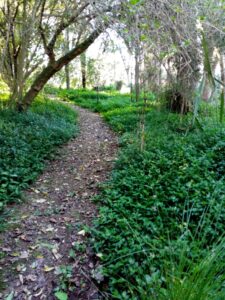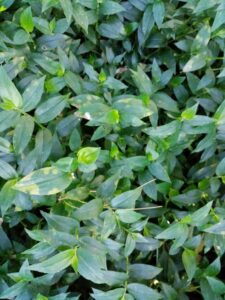Last year students/ākonga at Longburn School started to explore native plants with the idea of finding out what was growing in their “nature reserve”. The reserve was established over ten years ago and involved a massive amount of mahi to clear the area and replant with hundreds of native species.

The understory of the school bush area showing Tradescantia fluminensis carpeting the ground and reducing the chance of native species establishing.
During the exploration current ākonga noted the area had some large native trees and shrubs but looking at the forest floor they noticed only grass and a lush darker green plant that seemed to cover the entire area. Further investigation identified this to be an invasive pest plant called Tradescantia fluminensis (tradescantia).
Tradescantia is an introduced ground cover plant that creeps along forming mats and smothering other plant species. Having already researched about pest animals and the impact these have on our native fauna, students were keen to learn more about pest plants; what they are, how they threaten our native plants and ways they can take action to remove this weed and others from their nature reserve.
Ākonga put in some hard mahi weeding the tradescantia by hand and removing it by the sack load in the hope that the ferns and seedlings would be able to fill the space. However, they were disappointed to see that the tradescantia grew back quickly. The students found out that just a tiny fragment left on the ground can grow into a whole new plant. They realised that they had a real battle on their hands to control this weed.
The school reached out to Horizons Regional Council for some advice and suggestions on what they can do to manage the spread of this plant. They found out that the council has a Biosecurity Pest Plant team whose role it is to help landowners control or eradicate pest plants on their property. All regional councils, have a Regional Pest Management Plan which is a joint effort between regional councils, their communities and a host of other agencies that have a role in managing the effects of pests on economic and environmental values. Kelsi from Pest Plant team visited the school to check out their problem and suggested a few options. These included looking at biocontrol control agents that might be a safer way and more environmentally friendly solution to manage this invasive weed, instead of using chemicals, or spending hours of repetitive weeding.
Kelsi talked about two options. One was the tradescantia beetles, which either munch on the leaf, tip or stem, or the plant (depending on what species of beetle you have) and the other the yellow leaf spot fungus. The beetles are expensive and can be hard to get hold of, however the fungus was a potential option. Thankfully, Kelsi was able to source a few plants that were infected with the fungus. The school set aside a trial area in the nature reserve and Kelsi brought the infected plants in May 2022. She ran a session on how the fungus reproduces, and spreads, and what to look out for. She also reminded the students that biocontrol agents are not often a quick fix, and it takes patience and monitoring. This was a really cool school experiment to see if plants infected with the fungus could readily infect new plants if the “infected host plants” was simply planted in amongst the school’s tradescantia. Ākonga took on the responsibility of watering the infected plants until they settled into their new environment and the fungus had the best opportunity to spread. This project provided an empowering opportunity for ākonga, trialling some citizen science in their school and been responsible for monitoring the progress. Once the inoculated plants seemed to be established, the students waited and observed, and waited and observed some more.
“I learned that there are different ways to kill weeds other than just spraying them. Sometimes you can use other living things instead. It was fun to spend more time in the Nature Reserve and find all kinds of cool things there.” – Ākonga yr 6

Kelsi brings infected plants to Longburn school.

Establishing the infected plant in the rampantly growing Tradescantia population.

Leaves showing infection infected since planting the fungus-infected plant.
“I loved getting out of the classroom and I learned how to plant plants.” – Yr 6 student
Months passed by with very little change and it even looked like the fungus had disappeared altogether. However, ākonga kept checking on the area monthly (sometimes with the whole class, sometimes just with a few hard-core enthusiasts) to note any differences they could see. Nearly a year after the initial yellow spot fungus was introduced into the reserve students were excited to discover what they thought was fungus on plants several meters away from the trial area. They sent through some pictures to Kelsi who confirmed this was indeed the fungus and it has spread and looked to be working. The changes hadn’t been obvious over the last year, but it appears a lot had been happening under the radar.
“It was interesting to have to plant that infected plants. That was kind of weird as it seemed like we were adding more weeds. Now I get that it makes sense – we were adding the fungus, not really more plants.” – Yr 6 student comment
The process required a lot of patience but has been an empowering learning experience for ākonga with the added bonus that the tradescantia fungus has started to work. The students can’t wait to see how the fungus spreads further and what that will mean for their patch of native bush. They are hoping this will allow more space for other young native seedlings to start to emerge to fill up the forest floor.
“It was great to have the chance to use biocontrol against our Tradescantia problem, and cool that Kelsi could source the fungus for us. Wonderful for our students to learn that there are different ways of protecting our native plants. Thank you!” – Heather Gatehouse, Lead Enviroschools Teacher at Longburn School
